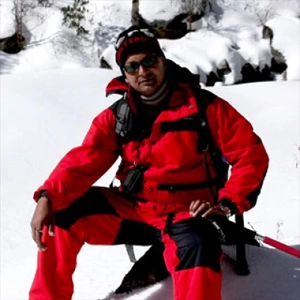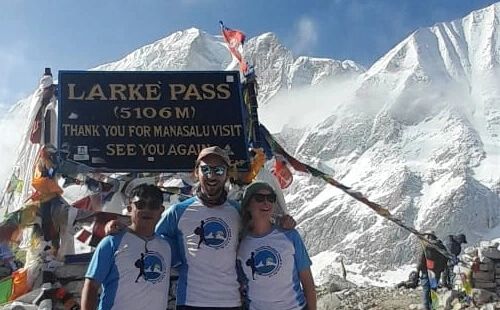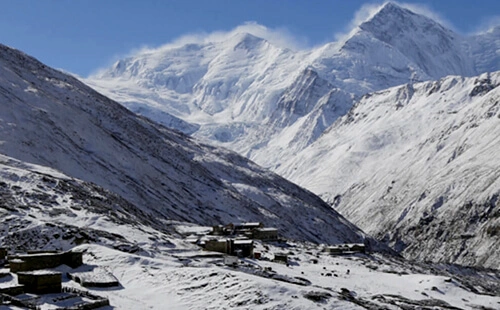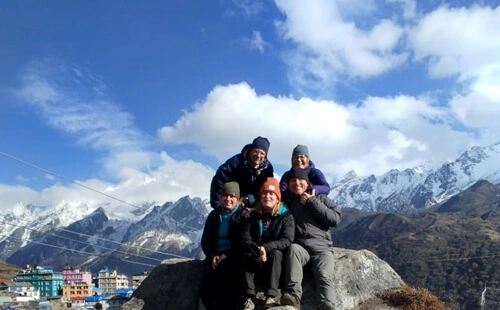Kala Patthar (5,545 m/18,192 ft), the top Everest Viewpoint
Located near Gorak Shep and Everest Base Camp in the Khumbu Region of Nepal at an elevation of 5,545 m/18,192 ft above sea level, Kala Patthar features arguably the most stunning sights of Mount Everest. Kala Patthar, which means “Black Rock” in Nepali, is not necessarily a peak but mostly a minor summit itself with a huge black rock.
Usually, the classic Himalayan route to the Everest Base Camp and Everest Summit itself, tracing the footsteps of legendary mountaineers Sir Edmund Hillary and Tenzing Norgay Sherpa, includes a visit to this popular viewpoint for expansive sights of the series of Himalayas dominated by Mt. Everest and acclimatization purposes before or after ascending to higher altitudes.
It offers one of the most close-up views of Everest without having to summit the peak itself. It is followed by unparalleled majestic sights of Lhotse, Nuptse, and others, especially during sunrise and sunset bathed in golden hues; hence, most trekkers opt for an early morning hike as part of the Himalayan Odyssey. Alternatively, one can choose to fly a helicopter directly from Lukla or Kathmandu, both as well.
Nonetheless, though the high altitude can add to the physical demand with risks of acute mountain sickness or altitude sickness, a hike to Kala Patthar View Point is a top-notch beginner-friendly destination that must be considered for an unmatchable panoramic sight of Mt. Everest to explore while in Nepal.
Gokyo Ri (5,357 m/17,575 ft ), the peak of the turquoise gem of the Everest Trekking Region
Gokyo Ri is yet another rocky summit of the Gokyo Valley of the Khumbu region, named after the serene, alpine turquoise lakes of Gokyo. Hence, at an altitude of 5,357 m/17,575 ft above sea level in the Everest Himalayas of Nepal, Gokyo Ri is usually part of the Gokyo Lakes Trek or the Three Passes Trek, which also serves as one of the best viewpoints to see Mount Everest.
This vantage point is nestled right next to the longest glacier in the Himalayas, Ngozumpa Glacier. It showcases the most stunning parts of the Everest Trekking Region in remote areas, including fragmented glaciers, tranquil lakes, pristine valleys, and jagged peaks, including Mt. Everest and the world's four tallest peaks, such as Mt. Makalu, Cho Oyu, Nuptse, and Lhotse.
Usually, the trail to reach Gokyo Ri from Lukla takes 14 days, making its way through Namche Bazaar and Gokyo Lakes set against the backdrop of snowy peaks and is comparatively less crowded. Therefore, the scenery from here is believed to be more epic than that from Kala Patthar, promising breathtaking views of Everest and the surrounding mountain peaks without much of the physical demands of a moderate climb.
It would be an extraordinary experience to get to scale Gokyo Ri voluntarily also involves visits to the gleaming Gokyo Lakes and quaint yet beautiful Gokyo Valley and villages only a few hours of ascents and descents, best for acclimatization to the highly elevated mountain areas.
Everest View Hotel (3,880 m/12,730 ft)
Also referred to as the highest altitude luxury hotel in the world in Nepal in the year 2004 is the Everest View Hotel at 3,880 m/12,730 ft above sea level. Established in the year 1971, the hotel is located a short hike above Namche Bazaar, offering incredible 360-degree spectacular views of Mount Everest and other Everest Himalayas while sipping warm tea on the terrace.
The hotel is at a comparatively lower altitude than other viewpoints of the Everest Region; hence, it is one of the best places to rest and grab a once-in-a-lifetime opportunity to marvel at Mount Everest’s majesty. A trek to where only is an ideal option for those who want to experience the Everest region without several days of high-altitude long treks in the Nepali luxury.
Besides Mount Everest, Everest View Hotel is renowned as the best place to witness the beauty of nearby mountain settlements, beautiful landscapes filled with herbs, shrubs, and evergreen deans forests of fir, rhododendron, and pine, added much by the awe-inspiring views of Mt. Changtse, Khumbutse, Nuptse, and Lhotse.
To reach here, trekkers, travelers, and visitors can take a mountain flight to Lukla and trek for 2-3 days to reach Namche Bazaar or can book a direct helicopter tour to Namche Bazaar and walk 2-3 hours uphill, where many also climb to the hotel as an acclimatization section on the way to the Everest Base Camp or other higher altitude routes.
Tengboche Monastery (3,867 m/12,687 ft), the spiritual center of the Khumbu Valley
Elevated at an altitude of 3,867 m/12,687 ft in the Everest/Khumbu region within the Sagarmatha National Park, also registered as one of the Natural UNESCO World Heritage Sites, Tengboche monastery is the largest gompa in the Khumbu Valley that also features a grand vista of Mount Everest.
Though locals revered it as a sacred pilgrimage for everyday offerings and prayers to their deity, and trekkers, climbers, and travelers visit to seek blessings so the journey goes smoothly, the Tengbohce Monastery also serves as a unique vantage point to view Mount Everest, particularly stunning during sunrise when the first ray of sun illuminates Everest, Ama Dablam, and Thamserku into orange, gold, and yellow.
Possibly it is one of the easiest viewpoints to explore Mount Everest, which is just a two-day trek from Namche Bazaar on the Everest Base Camp (EBC) trail to appreciate the snow-covered Everest framed by the beauty of ancient architecture and cultural and religious significance, especially during the Mani Ridum Festival that is held on an annual basis coinciding with autumn.
Further, it will be exciting to observe the daily lives of local Sherpas as you make your way through pine trees, vibrant forests of rhododendrons, and oak, eventually leading you to Tengboche village and monastery, offering rich cultural and natural insight that you would not like to miss.
Kong Ma La (5,535 m/18,159 ft)
One of the three high-altitude passes in the Everest region, Kongma La, undoubtedly falls under one of the best Everest Viewpoints. It is the highest of three passes on the Everest Three High Passes Trek route connecting the Khumbu Valley to the Imja Valley, even at a greater height than the Everest Base Camp.
Sitting at an elevation of approximately 5,535 m/18,159 ft, it is a connecting pass between Lobuche and Chhukung blessed with the heavenly sights of Ama Dablam, Makalu, Lhotse, and, of course, Everest. That, however, is not without challenging rugged terrain, steep ascents, and descents, so make sure you are both mentally and physically prepared with basic mountaineering skills accompanied by high-quality climbing gear and a professional Sherpa guide that we offer.
Nonetheless, Kong Ma La Pass is a fantastic vantage point that has one of the most mesmerizing views of Mount Everest, added much by the glorifying sights of rivers and lakes, including that of the Khumbu glacier. As you approach the past, it rewards you significantly and comes with its own set of challenges and an immeasurable sense of achievement, satisfaction, and adventure.
Renjo La Pass (5,360 m/17,585 ft)
The second of the Three High Pass Treks in Everest is the Renjo La Pass in the western part of the Khumbu region, at around 5,360 m/17,585 ft above sea level in height. For adventurous spirits, the pass is a haven that connects the Gokyo Valley with the Thame and has exceptional views of some of the major highlights of the entire Everest Trekking region, including Kala Patthar, Cho La glaciers, Tengboche Monastery, and Mount Everest, followed by others.
Though underrated, the top of the pass provides ethereal views of at least eight of the world’s largest mountain peaks, such as Lhotse, Makalu, Cho Oyu, Pumori, Nuptse, Thamserku, and Ama Dablam after Mount Everest. While we talk about the otherworldly scenery, it is important to note that the route can be difficult for novices to tackle; hence, it is advisable to begin physical preparedness three months before the trek reaching Renjo La Pass begins.
This is a dream come true journey for adventure lovers looking forward to challenging themselves in the higher Himalayas with unpredictable weather conditions, rugged and steep routes requiring a good level of physical fitness, climbing skills, and unswayed determination to lastly end the day with a refreshing cup of warm tea, appreciating the shimmering glacial views above and traditional Sherpa dwellings below as you stand straight to the top of the world, Mt. Everest.
Cho La Pass (5,420 m/17,782 ft)
Connecting the village of Dzongla to the east of the Khumbu Valley and the village of Thagnak to the west, Cho La is the second pass of the Three High Pass Trek in the Everest Himalayas of Nepal, which also joins the Everest Base Camp Main route with the Gokyo region, involving traversing through some icy routes, mountains, rugged terrain, and steep ascends and descends worth a shot, promising an unforgettable view of Mount Everest.
To reach this one of the iconic passes under the Sagarmatha National Park, trekkers, travelers, and visitors are required to board a thrilling flight to Lukla and engage in several days of trekking through the Dudh Koshi Valley, passing by Namche Bazaar heading to specifically Gokyo Lakes and Valley, finally making it to an altitude of 5,420 m/17,782 ft at Cho La Pass with magnificent views of the Gokyo Lakes on the Gokyo side and Khumbu Ghalciers and peaks while in the Khumbu side.
The trail is gradually ascending through patches of rhododendron and birch forests home to elusive musk deer and summer settlements of yak. Expect the route to be physically demanding with good availability of tea houses balanced by equally breathtaking views of peaks like Ama Dablam, Cholatse, and Lobuhce East, including Mount Everest; hence, it is also included in the list of the best Everest viewpoints in Nepal.
Chukung Ri (5,550 m/18,209 ft)
Yet another very popular trekking peak and viewpoint in the Everest region is Chukung Ri near the traditional village of Chhukung, above Dingboche, in the Imja Valley. Standing tall at an elevation of 5,550 m/18,209 ft, the peak is moderately difficult and non-technical, and often trekkers use it as an acclimatization summit before continuing the journey to the higher altitude, precisely for Island Peak or Kong Ma La Pass.
The route has steep and rocky sections more famous for fantastic views of Island Peak and Lhotse, particularly along with one of the most amazing looks out at the world’s top mountain, Mount Everest (8,848 m), followed by the stunning beauty of Imja Glacier, Makalu, and Baruntse during the clear days.
In conclusion, Chhukung, a non-technical peak in Nepal's Khumbu region, offers magnificent views of the surrounding Himalayan peaks such as Lhotse, Makalu, Ama Dablam, and others. It is also one of the best viewpoints to explore Mount Everest while in Nepal. For an incredibly thrilling yet accessible Himalayan experience, it is worth a challenge.
Namche Bazaar (3,440m/11,286ft)
Taken as the major gateway to the Everest region of Nepal, Namche Bazaar is a vibrant Sherpa town nestled at 3,440m/11,286ft. Serving as a popular stop for acclimatization for trekkers on the way to Everest Base Camp and other famous trekking, hiking, and climbing routes, it is also one of the best viewpoints, featuring stunning vistas of Kongdee Ri, Thamserku, and others, including the distant yet mesmerizing sight of Mount Everest.
In fact, it is the very first viewpoint to see Mt. Everest at an elevation of 3,440 m above sea level nestled amidst the sky, towering mountain ranges such as Kongde Ri, Kususm Kangru, Thamserku, Khongeta, and others. Set like a horseshoe-shaped bowl, Namche Bazar features well-established numbers of lodges, stores, three-star hotels, and tea houses catering to the needs of trekkers, visitors, travelers, and climbers.
Further, there is a weekly market held every Saturday in the center of the Namche village, providing a deeper insight into the customary life of locals, primarily Sherpas. Buy some souvenirs while you also catch one of the most spectacular views of the world’s top, Mount Everest.
Nagarjun Hill, Dingboche (5,050 m)
Also known as Nangkartshang Peak, located only 4 km from the traditional village of Dingboche at an elevation of 5,050 m above sea level, Nagarjun Hill is famous for its fantastic views of the snow-capped peaks and looks out at the entire Everest/Khumbu region, including the ethereal sight of Mount Everest.
Though the trail is windy and it is advisable to be cautious with layered clothing, it is one of the best acclimatization spots that rewards trekkers with panoramic views of Ama Dablam, Lhotse, Makalu, and even peeks of Mount Everest. Usually, this viewpoint is visited as a part of the Everest Base Camp Trek, which is worth the effort for yet another unique perspective.
Farak Ri, Kongde (15,354ft/4,680m)
At the north of Kongde Village in the Khumbu region, under one of the Natural UNESCO World Heritage Sites of Nepal, the Sagarmatha National Park is yet another remarkable viewpoint to explore Mount Everest while in your visit Nepal called Farak Ri. Set at an altitude of 4,680 m above sea level, many often opt for a peak alone in the Everest Panorama Trek package that lets mountain enthusiasts interact with the majestic mountains lying parallel to trekkers' eyesight.
Comparatively in the lower Everest region, is a hidden gem and usually is less crowded than other viewpoints, offering excellent and unspoiled natural beauty of the surroundings. Rich in flora and fauna, the viewpoint is approximately a 9-hour walk from Namche Bazaar, taking you deeper into the forests of rhododendron, pine, and bamboo, all watched over by Mt. Everest, Lhotse, Makalu, Cho Oyu, and the Khumbu Valley.
It would be amusing to catch a 360-degree view of not only Mount Everest but also other towering Himalayan giants, for which you can also ride a short direct helicopter trip, purchase the Kalapatthar Helicopter Tour stooping at Khongde Farak for breakfast or lunch, or get your itinerary customized at Adventure Himalayan Travels and Treks so we can allocate a hike to Farak Ri, one of the best views of Mount Everest.
Pikey Peak (4,100 m/13,494 ft)
Pikey Peak, at an elevation of 4,100 m/13,494 ft above sea level in the Solu region, is a relatively newly opened and off-beaten excellent alternative to the Everest Base Camp Trek for adventurers seeking a more comfortable and less strenuous hike to marvel at the serene beauty of Mount Everest.
However, one can also choose to combine the EBC Trek with a side excursion to Peaky Peak, which, if approached as a main destination, is easier, more beginner-friendly, and budget-friendly than the Everest Base Camp Hike, suitable for trekkers of varying age groups if physically fit, typically lasting from 6-8 days.
The trail to Peaky Peak is mostly easygoing and does not mandate high-altitude climbing experience and skills, offering astounding views of some of the highest peaks in the world, including Mt. Dhaulagiri in the west, Mt. Kanchenjunga in the east, and Mt. Everest (8,848 m), the highest peak of the earth dominating the sky horizon as seen from the top. Hence, Peaky Peak stands out as one of the ideal sports for Mount Everest viewing while in Nepal.
Pangboche (3,985 m/13,074 ft)
Nestled along the classic Everest Base Camp route, once traversed by legendary mountaineers Sir Edmund Hillary and Tenzing Norgay Sherpa, Pangboche or Panboche village in the Everest region of Nepal offers stunning views of Mount Everest and other peaks like Ama Dablam, Lhotse, and Thamserku; hence, is one of the best viewpoints to explore Mount Everest while in Nepal.
Located high in the Himalayas at an altitude of 13,074 ft (3,985 m) in the Imja Khola Valley, around 3 km northeast of Tengboche monastery, Pangboche is famed for the “Yeti” scalp and hand-kept as a ritual artifact at the Panboche Monastery, the oldest religious Buddhist site of the Khumbu region.
The village's proximity to some of the key Everest viewpoints, such as Dingboche, Tengoboche, and others, including Dughla Lake, and the pass to the north charms trekking, climbing, nature, and adventurous spirit alike, making it a must-visit viewpoint that adds much to the cultural, religious, and spiritual experience on your visit, as you are also blessed with crystal clear views of the Himalayan panorama.
Poon Hill, (3,210m) Annapurna Region
Though Poon Hill at an altitude of 3,210m above sea level in the Annapurna Trekking region of Nepal is primarily taken into consideration for breathtaking views of the Annapurna and Dhaulagiri ranges, on a clear weather day, you can catch a distant glimpse of the earth’s highest point, Mt. Everest (8,848 m) as well.
The Trek to Poon Hill passes through charming villages of Gurung and Magar, adding cultural dimensions, while the hill itself is famous for out-of-the-world sunrise and sunset views. Easily accessible and comparatively short, hence Poon Hill is an ideal destination for photography enthusiasts without having to engage oneself in a several-day strenuous trek.
Additionally, if you are looking forward to appreciating Mount Everest en route to the Annapurna Base Camp Trek or Annapurna Circuit Journey, a side trip to Poon Hill or Khopra Danda (3,640 m/11,942 ft) is a must.
Nagarkot ( 2,175 m/7,136 ft)
Just 32 km from the capital city of Nepal, Kathmandu, Nagarkot, at an altitude of 2,175 m/7,136 ft, is one of the best viewpoints in Nepal to observe Mount Everest. For those with limited stays yet still seeking a true Himalayan experience embraced by the serenity of nature and mountains, Nagarkot is just the perfect escape.
Visitors are rewarded with breathtaking panoramic views of the Himalayas, such as Langtang, Ganesh Himal, and Annapurna, including Mount Everest, without trekking into the high-altitude Himalayas. The road to here is easily accessible by road, offering a wide variety of accommodations, meal options, and other amenities ranging from luxury resorts to budget guest houses, and others crafting a convenient and comfortable way for you to explore Mount Everest near the city of Kathmandu itself.
Hence, speaking of Nagarkot, all in all, it is a wonderful destination and the best way to see Everest for tourists seeking seclusion and a great diversity of views, including stunning views of the sunrise and sunset over the mountains, providing a great insight into the beauty of the Himalayas, at the same time requiring no multiple-day trekking to do so.
Conclusion
To conclude, if you are wondering how to see Everest while in Nepal, The Himalayan country of Nepal offers a wide range of marvelous viewpoints to explore and capture the essence of Mount Everest that captivates the hearts of people from all over the world, each promising a distinctive perspective.
Kala Patthar, Gokyo Ri, Farak Ri, Nagarjun Hill, Chukung Ri, and Peaky Peak are ideal for expansive, panoramic views of Everest and the surrounding Himalaya giants; Namche Bazaar, Everest View Hotel within, Tengboche, and Pangboche combine the clear views of Everest with rich Sherpa culture and historical significance.
Where Kong Ma La, Cho La, and Renjo La passes are added to the trekking part, they leave behind a feeling of accomplishment, adventure, and peace when one decides to go beyond his/her limits, Poon Hill and Khopra Ridge in the Annapurna area, and Nagarkot, which offer a sneak peek of the mighty Everest. Each viewpoint caters to specific trekkers and styles.
Connect with us now for an extraordinary, authentic, and true Himalayan exploration, be it towards the top of the world, Mt. Everest, restricted lands of Upper Mustang, or a short trek to Langtang Valley in Nepal, and other beautiful Himalayan countries of Tibet, Bhutan, and India.




